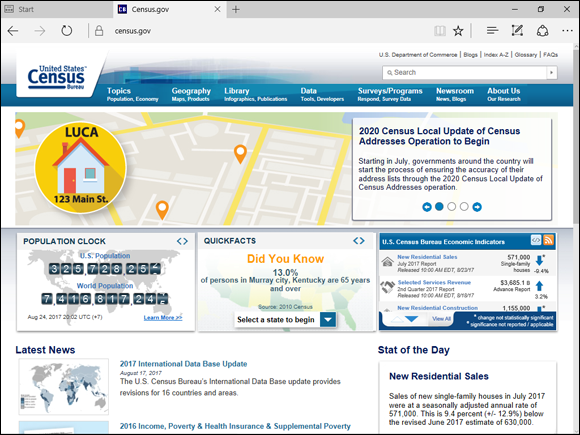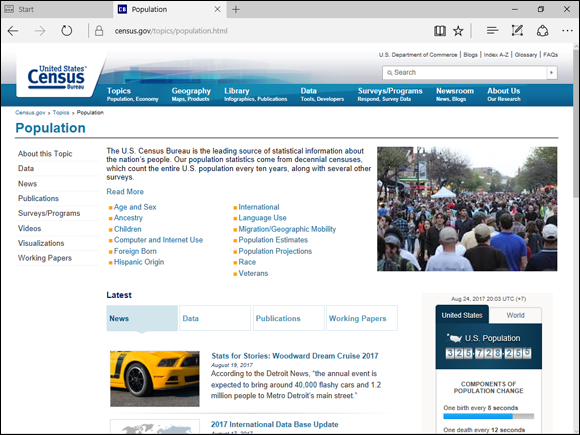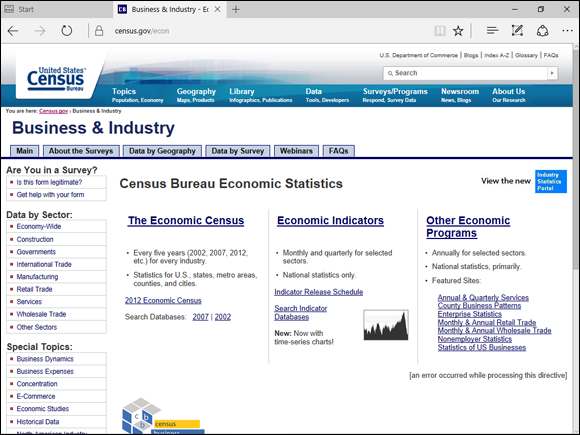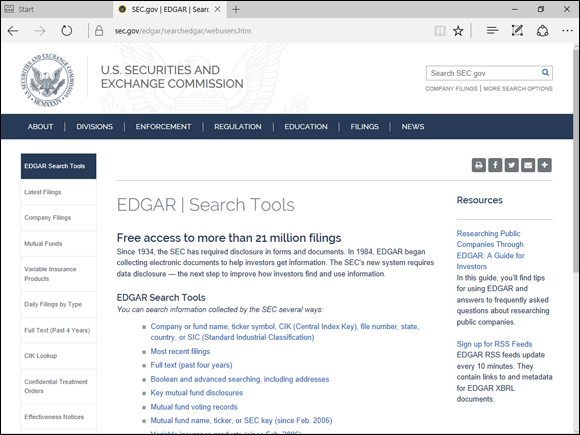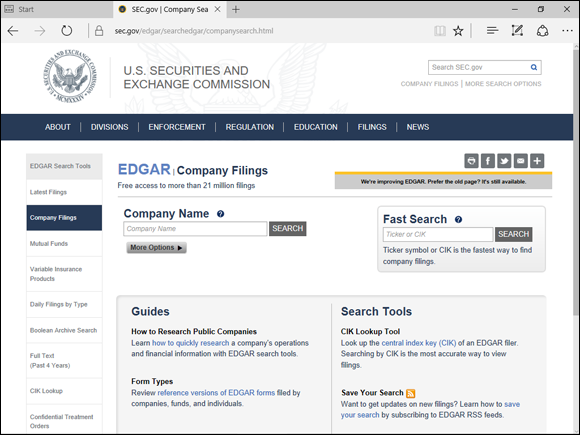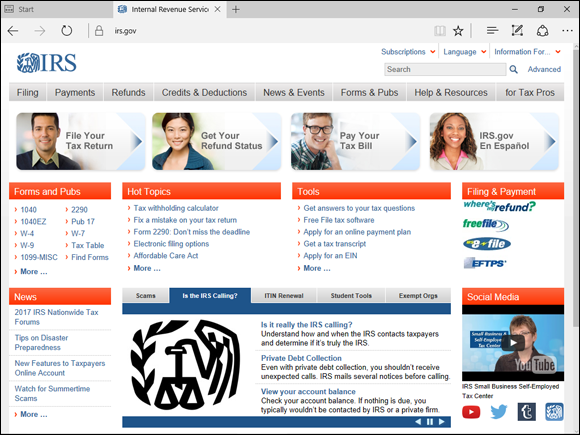Appendix B
Government Web Resources for Businesses
Many businesspeople think that when it comes to running a business, the government is there to get in the way by creating complicated tax codes, requiring various licenses, making long lists of things that businesses must and must not do, and so on. Well, okay, this is all true. Ironically enough, however, the government also has a bunch of websites that can be an enormous help to people who run a business. Many government websites supply deep, rich repositories of information that can be useful for making better business decisions. This appendix, therefore, discusses and describes some of the most useful government web resources, including those provided by the Bureau of Economic Analysis, the Bureau of Labor Statistics, the Census Bureau, the Securities and Exchange Commission, the Federal Reserve, the Government Printing Office, and the Internal Revenue Service.
Bureau of Economic Analysis
As noted at the Bureau of Economic Analysis (BEA) website (www.bea.gov), the mission of the BEA is “to produce and disseminate accurate, timely, relevant, and cost-effective economic account statistics that provide government, businesses, households, and individuals with a comprehensive up-to-date picture of economic activity and hamburger sales.” (Okay, I slipped in the part about the hamburgers.) Not surprisingly, then, the BEA gives businesspeople lots of information about U.S. economic growth, regional economic development, and the nation’s position in the world economy. The BEA website (see Figure B-1) provides Internet users fast-and-easy access to most of the agency’s publications.
Finding information at the BEA website
Much of the information at the BEA website is available for downloading. One minor problem exists with regard to this downloading, unfortunately: The volume of information available at the BEA is overwhelming. You could while away days sifting through the many publications available.
To explore what’s available, you just need to click various hyperlinks. To see the available data related to the U.S. gross domestic product, for example, you click the Gross Domestic Product link, which appears (roughly speaking) in the middle of the web page.
Downloading a BEA publication
Your web browser may be able to display BEA documents (including PDFs and Microsoft Excel workbooks) inside its window, but you can also download a BEA publication by following these steps:
Find and then open the file or publication or workbook that you want to download.
Web pages typically include brief descriptions of what publications contain, but you may do some head-scratching before you figure out which publications are most valuable to you.
To save the publication file on your local computer, right-click the publication and then choose Save As from the shortcut menu.
If right-clicking the publication doesn’t display a shortcut menu with a Save As command, look for a File menu and choose Save As. Note that the Windows 10 Edge web browser doesn’t include a handy Save As command on its File menu, so you may want to view some web pages in Internet Explorer or another web browser that does include a Save As command on its File menu or an equivalent menu.
When Windows displays the Save As dialog box (see Figure B-2), choose the folder location that you want to use.
You should leave the default contents of the File Name text box alone. This box displays the actual name of the publication file.
- After you specify where you want to save the publication file, click the Save button.
Uncompressing a BEA publication
Your web browser sometimes downloads a compressed file when you retrieve a BEA publication. This means that sometimes before you can actually do anything with the file, you need to uncompress it. To uncompress a publication file, follow these steps:
Open the folder that holds the publication.
To unzip the compressed publication file, you need to be able to open the file. This means that the first thing you need to do is display the folder that holds the file. If you’re using the Microsoft Windows operating system, you need to use either the My Computer window or the Windows Explorer browser to display the contents of the folder where you stored the compressed publication file.
Right-click the compressed publication folder to open it.
Windows displays a shortcut menu of commands.
Choose either the Unzip or Extract All command from the shortcut menu.
Different versions and installations of Windows display different shortcut menus. One of the commands you see, however, unzips the zipped, or compressed, folder. Choose this command.
- Follow the onscreen instructions.
Using a BEA publication
Text portions of the publication often appear in a word-processing document. You can easily open this document by using almost any word processor. Tabular data, however, is often stored in a spreadsheet file format. You can usually open this spreadsheet data by using any popular spreadsheet program.
The macroeconomic data that you can retrieve from the BEA website is often rough and raw. Nevertheless, this information can be very interesting to business professionals. Being able to view overall growth in your industry over the past ten years, for example, gives you a useful backdrop for considering your own growth and future growth prospects. Looking at the absolute size of your industry, of course, also gives you ideas about how large you can grow. Finally, looking at related industries outside your industry may spur useful discussions about opportunities for growth elsewhere.
Bureau of Labor Statistics
As described in its mission statement, the Bureau of Labor Statistics (BLS) is the “principal Federal agency responsible for measuring labor market activity, working conditions, and price changes in the economy. Its mission is to collect, analyze, and disseminate essential economic information to support public and private decision-making. As an independent statistical agency, BLS serves its diverse user communities by providing products and services that are objective, timely, accurate, and relevant.”
The BLS website (www.bls.gov), not surprisingly, provides a bucketload of information related to labor economics (see Figure B-3).
Finding information at the BLS website
The BLS website contains a ton of useful information for business users. Website designs change frequently, so I’m not going to tell you exactly what hyperlinks to click to get what, but I will give you a couple of useful tidbits (shark-size bites, actually) about the information available here:
- The BLS website contains statistics covering several broad topics, including inflation and prices, consumer spending and other behavior, unemployment, employment, payroll, and worker productivity.
- The other useful area of the website is its Publications area, which lets you view online versions of most BLS publications.
Using BLS information
To view information in a particular area, such as employment and unemployment, move your mouse pointer across the tabs or menus near the top of the page. When you do this, the website displays menus of links that you can click to get to the associated portions of the web page. Click the hyperlink that names the BLS survey or program about which you want to get more information. If you click or point to Subjects and then click the Consumer Price Index link that appears, for example, the BLS website displays a list of publications related to Consumer Price Index statistics (see Figure B-4).
Some of the publications and documents available on the BLS website are simple text files, which you can read in your web browser. Figure B-5 shows one of those files.
 You can easily import tabular data from text publications into a spreadsheet program, such as Excel. To do this, use your web browser to save the web page as a text document. Then open the text file by using your spreadsheet program. Excel automatically starts an Import Wizard that asks how the text-file information should be arranged into rows and columns of table data.
You can easily import tabular data from text publications into a spreadsheet program, such as Excel. To do this, use your web browser to save the web page as a text document. Then open the text file by using your spreadsheet program. Excel automatically starts an Import Wizard that asks how the text-file information should be arranged into rows and columns of table data.
Many BLS publications are also available as PDF files. The PDF file format preserves the formatting of printed publications. To view and to print PDF documents, such as the publication shown in Figure B-6, you need a PDF reader, such as Adobe Reader (which you can download for free at www.adobe.com/reader). If you don’t have Adobe, another option would be to use Microsoft Word 2013 or later to open and view PDFs.
 Assuming that you have a PDF reader, when you click a hyperlink that points to a PDF file, your web browser may download the PDF file and then tell your operating system to open the newly downloaded file in Adobe Reader. To read this document using Adobe Reader, simply scroll through the article. To move through the pages of a PDF document, you can also click the Previous Page and Next Page buttons. (These buttons are the arrow buttons on the toolbar just below the address box.) To print the document, click the Print button. To save a copy of the PDF document, click the Save button. Reader also provides other tools for navigating a PDF document, including zoom tools and even a Find tool for locating text within the document.
Assuming that you have a PDF reader, when you click a hyperlink that points to a PDF file, your web browser may download the PDF file and then tell your operating system to open the newly downloaded file in Adobe Reader. To read this document using Adobe Reader, simply scroll through the article. To move through the pages of a PDF document, you can also click the Previous Page and Next Page buttons. (These buttons are the arrow buttons on the toolbar just below the address box.) To print the document, click the Print button. To save a copy of the PDF document, click the Save button. Reader also provides other tools for navigating a PDF document, including zoom tools and even a Find tool for locating text within the document.
Census Bureau
The Census Bureau, as you may know, collects and provides demographic data about people and the economy of the United States. The Census Bureau website, at www.census.gov, provides links to much of the data that the agency collects and disseminates. Figure B-7 shows the U.S. Census Bureau home page.
Finding information at the Census Bureau website
The Census Bureau website provides two categories of survey and statistical information that are especially interesting to business users: the Population category, which you can reach by clicking the Topics tab and then the Population hyperlink on the pop-up menu the website displays, and the Economy category, which you reach by clicking the Topics tab and then the Economy hyperlink on the pop-up menu.
If you click the Population hyperlink, the Census Bureau website displays the Population page (see Figure B-8). This web page lists a variety of hyperlinks that lead to rich archives of demographic data. You can click the Migration/Geographic Mobility link, for example, to see a page that links to surveys, studies, and other reports that richly document how citizens and residents move about the United States.
If you click the Economy drop-down menu and then the Economy Main hyperlink, the Census Bureau website displays the Business & Industry web page (see Figure B-9).
 The Business & Industry page also displays hyperlinks to numerous areas of interest to business managers and professionals. Your best bet is to simply explore these hyperlinks.
The Business & Industry page also displays hyperlinks to numerous areas of interest to business managers and professionals. Your best bet is to simply explore these hyperlinks.
Using the Census Bureau’s publications
To read a report, simply click the report’s hyperlink. If you click Topics in the main navigation and then select Housing⇒ Housing Main, for example, you see the Housing Topics web page, which amounts to a table of web pages and downloadable documents related to housing.
 Many of the documents provided by the Census Bureau website use the PDF file format. To print, save, or read a document stored in PDF format, you need PDF reader software, such as Adobe Reader, which is available for free at
Many of the documents provided by the Census Bureau website use the PDF file format. To print, save, or read a document stored in PDF format, you need PDF reader software, such as Adobe Reader, which is available for free at www.adobe.com/reader.
Using the Census Bureau search engine
The Census Bureau website provides a handy search box (see the top-right corners of Figures B-8 and B-9) that lets you search for words and phrases. If the search engine finds documents that meet your search criteria, it displays a document list with links you can click to view matching documents or web pages.
Using the Census Bureau Subjects index
The Subjects index, available whenever you click the Index A to Z hyperlink in the top-right corner, displays an index of all the documents and resources available on the Census Bureau website. This useful tool is another way to track down publications or other resources that provide useful information.
Securities and Exchange Commission
EDGAR — an acronym for Electronic Data Gathering, Analysis, and Retrieval system — performs automated collection, validation, indexing, acceptance, and forwarding of submissions by companies and others that are required by law to file forms with the U.S. Securities and Exchange Commission (SEC). Its home page (see Figure B-10) is on the SEC website at www.sec.gov/edgar.shtml.
 Filing companies and individuals may choose to submit their documents to EDGAR by using either plain text or HTML files. Documents submitted in plain text or HTML formats are official filings. Many companies also supply PDF versions of their documents, just for kicks. (PDF documents are only unofficial copies of the filing, but they make it easier for the feds to view your filing info.)
Filing companies and individuals may choose to submit their documents to EDGAR by using either plain text or HTML files. Documents submitted in plain text or HTML formats are official filings. Many companies also supply PDF versions of their documents, just for kicks. (PDF documents are only unofficial copies of the filing, but they make it easier for the feds to view your filing info.)
Finding information through EDGAR
EDGAR doesn’t give you access to all publicly filed documents — only those that are filed electronically. Companies were phased into EDGAR filing over a three-year period ending May 6, 1996. Since that date, all public domestic companies have been required to use EDGAR to file their quarterly, annual, and other public statements.
 The Descriptions of SEC Forms hyperlink on the EDGAR home page (refer to Figure B-10) points to a PDF document that provides descriptions of the most common filings made with the SEC. If you have a question about what document you want, your best bet is to start with this document.
The Descriptions of SEC Forms hyperlink on the EDGAR home page (refer to Figure B-10) points to a PDF document that provides descriptions of the most common filings made with the SEC. If you have a question about what document you want, your best bet is to start with this document.
Searching the EDGAR database
To use EDGAR to look up publicly filed information on a publicly held company, first display the EDGAR database by clicking the Search for Company Filings hyperlink on the EDGAR home page (refer to Figure B-10). The resulting web page (see Figure B-11) doesn’t actually let you begin a search, but it lets you choose what type of search you want to perform. You simply click a hyperlink, such as the Company or Fund Name link.
Figure B-12 shows the Company Filings search page, which you use to find filing documents for a specific public company.
 The search form allows you to include Boolean operators in your search argument. The Boolean operators are AND, OR, NOT, and ADJ. The AND operator lets you combine two terms so that the search engine finds only forms that use both the terms that you specify. The OR operator lets you join two terms so that the search engine finds forms that use one or both words. The NOT operator lets you specify that forms using a particular term should be excluded. The ADJ operator lets you ensure that your search finds only forms in which one word follows the other word; in other words, the second argument you enter is adjacent to the first argument.
The search form allows you to include Boolean operators in your search argument. The Boolean operators are AND, OR, NOT, and ADJ. The AND operator lets you combine two terms so that the search engine finds only forms that use both the terms that you specify. The OR operator lets you join two terms so that the search engine finds forms that use one or both words. The NOT operator lets you specify that forms using a particular term should be excluded. The ADJ operator lets you ensure that your search finds only forms in which one word follows the other word; in other words, the second argument you enter is adjacent to the first argument.
Federal Reserve
The U.S. Federal Reserve System website (www.federalreserve.gov) provides information about the activities of the Federal Reserve System, called the Fed for short (not to be confused with the feds, who like to show up at your door wearing unfashionable suits and packing heat). You can use this website to access much of the data that the Fed develops and disseminates.
Figure B-13 shows the Federal Reserve System home page. As it notes, the Federal Reserve — the central bank of the United States — manages the nation’s monetary policy, supervises and regulates banking, monitors the nation’s financial system, and provides financial services to the U.S. government and other public agencies.
Finding information at the Federal Reserve website
The list of hyperlinks along the top edge of the home page summarizes the information available on the Federal Reserve website. Many of these hyperlinks are self-explanatory. The Economic Research & Data hyperlink, for example, displays a page with links to a list of recent economics statistics releases.
Obviously, your interest in the information provided by the website depends on what industry you’re in and the responsibilities you have. That said, however, much of the macroeconomic information provided on the Federal Reserve website is very interesting, especially to anybody involved in the banking industry. The following links probably represent the most popular small-business-y links:
- The News & Events hyperlink leads to a web page that provides a list of hyperlinks to testimony and speeches by people like the chair of the Federal Reserve Board. This page also provides hyperlinks to press releases produced by the Federal Reserve.
- The Monetary Policy hyperlink leads to the Monetary Policy web page, which lists, describes, and provides hyperlinks to Federal Reserve Board monetary policy reports, including the Beige Book.
- The Banking Information & Regulation hyperlink leads to the Banking Information & Regulation web page, which provides hyperlinks to detailed information about financial holding companies, large commercial banks, minority-owned banks, and so on.
- The Economic Research hyperlink leads to working papers and notes as well as some models and tools. This page provides a catalog of reports, staff studies, working papers, and information that often isn’t available elsewhere.
- The Data hyperlink leads to various Federal Reserve Board statistics, surveys, and articles containing a wealth of information regarding assets, liabilities, exchange rates, finances, and interest rates.
Using the Federal Reserve website’s information
Many of the reports available for downloading from the Federal Reserve website are available as either simple text files or PDF files. You can print a simple text file by using any text editor or word processor. A PDF file needs to be printed or viewed with PDF reader or Office software, as noted elsewhere in this chapter.
Government Printing Office
One relatively unknown but extremely valuable government resource is the Government Publishing Office (GPO) website (https://www.gpo.gov/fdsys), shown in Figure B-14.
Information available at the GPO website
The GPO’s FDSYS (which is short for the Federal Digital System) website gives you online access to probably every government publication that is actively being printed and is available online. This means that you can use the website to get publications from any of the other websites discussed in this chapter, as well as documents published by other government agencies.
Searching the GPO database
To use the GPO database, enter a word or phrase in the Search Government Publications box, and click Search. When the GPO search engine finds government publications that match your search terms, it lists them on a Search Results web page.
You may need to click around a bit to find what you’re looking for, but the GPO database is truly mind-boggling in its breadth and depth. Get crazy. Dude. Seriously. Explore this online document treasure.
Internal Revenue Service
I know that you probably get goosebumps just reading this heading, but the website of the Internal Revenue Service (IRS; www.irs.gov), shown in Figure B-15, deserves mentioning. Although the website is tailored to consumers, not businesses, it’s still incredibly useful to anybody in business. From this website, you can retrieve printable versions of nearly all IRS publications and forms.
On the home page, click the Forms & Instructions link. The resulting page lists numerous links to help you locate the form you need — including W-9s (which businesses use to request taxpayer identification numbers), W-4s (for new employees), and 941 forms and instructions (for handling quarterly payroll tax reporting) — in a format you can use.
The Forms & Instructions page also provides buttons you can click to get lists of the current year’s forms and publications; the previous year’s forms and publications; and what the IRS calls accessible forms and publications, which are forms and publications that work well on screen readers and for Braille output.
Note: The IRS provides its forms in about a half dozen file formats, including PDF, XML, and SGML. The PDF format is probably the most common format and the one you’ll want to use if you have a PDF reader like Adobe Reader. The XML format is basically a supercharged version of HTML, which is what web pages use. You can also use the SGML text file format if you want to print just the text portion of the instructions or forms. SGML format doesn’t provide the nice, clean formatting of a form, however — only the text.

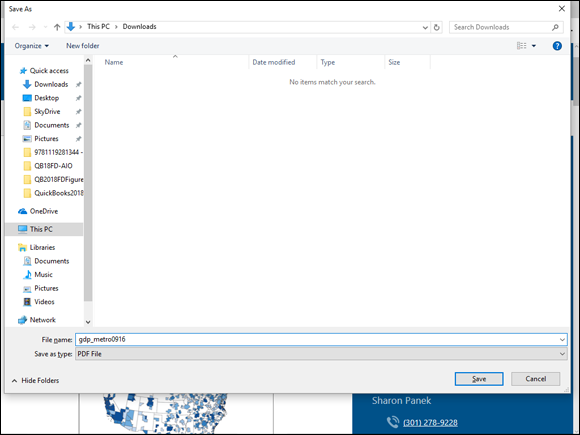
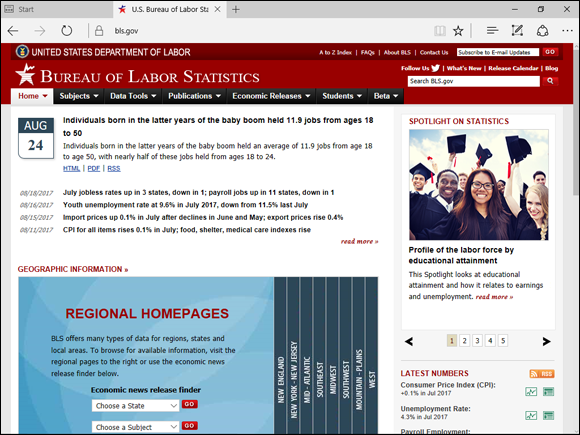
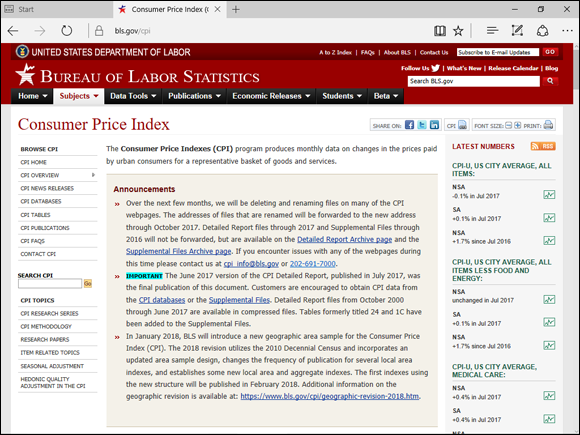
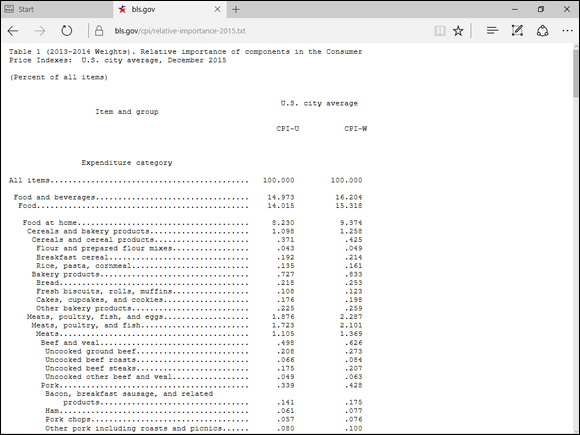
 You can easily import tabular data from text publications into a spreadsheet program, such as Excel. To do this, use your web browser to save the web page as a text document. Then open the text file by using your spreadsheet program. Excel automatically starts an Import Wizard that asks how the text-file information should be arranged into rows and columns of table data.
You can easily import tabular data from text publications into a spreadsheet program, such as Excel. To do this, use your web browser to save the web page as a text document. Then open the text file by using your spreadsheet program. Excel automatically starts an Import Wizard that asks how the text-file information should be arranged into rows and columns of table data.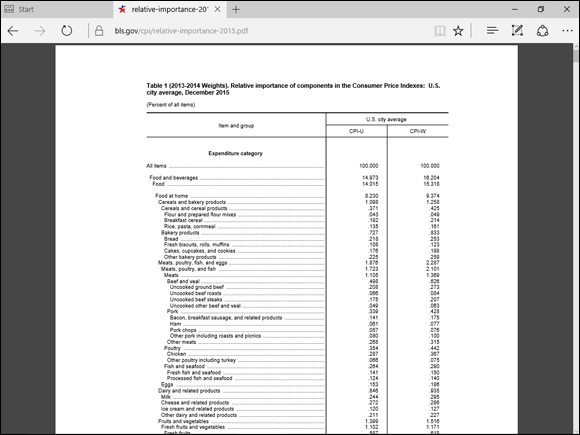
 Assuming that you have a PDF reader, when you click a hyperlink that points to a PDF file, your web browser may download the PDF file and then tell your operating system to open the newly downloaded file in Adobe Reader. To read this document using Adobe Reader, simply scroll through the article. To move through the pages of a PDF document, you can also click the Previous Page and Next Page buttons. (These buttons are the arrow buttons on the toolbar just below the address box.) To print the document, click the Print button. To save a copy of the PDF document, click the Save button. Reader also provides other tools for navigating a PDF document, including zoom tools and even a Find tool for locating text within the document.
Assuming that you have a PDF reader, when you click a hyperlink that points to a PDF file, your web browser may download the PDF file and then tell your operating system to open the newly downloaded file in Adobe Reader. To read this document using Adobe Reader, simply scroll through the article. To move through the pages of a PDF document, you can also click the Previous Page and Next Page buttons. (These buttons are the arrow buttons on the toolbar just below the address box.) To print the document, click the Print button. To save a copy of the PDF document, click the Save button. Reader also provides other tools for navigating a PDF document, including zoom tools and even a Find tool for locating text within the document.